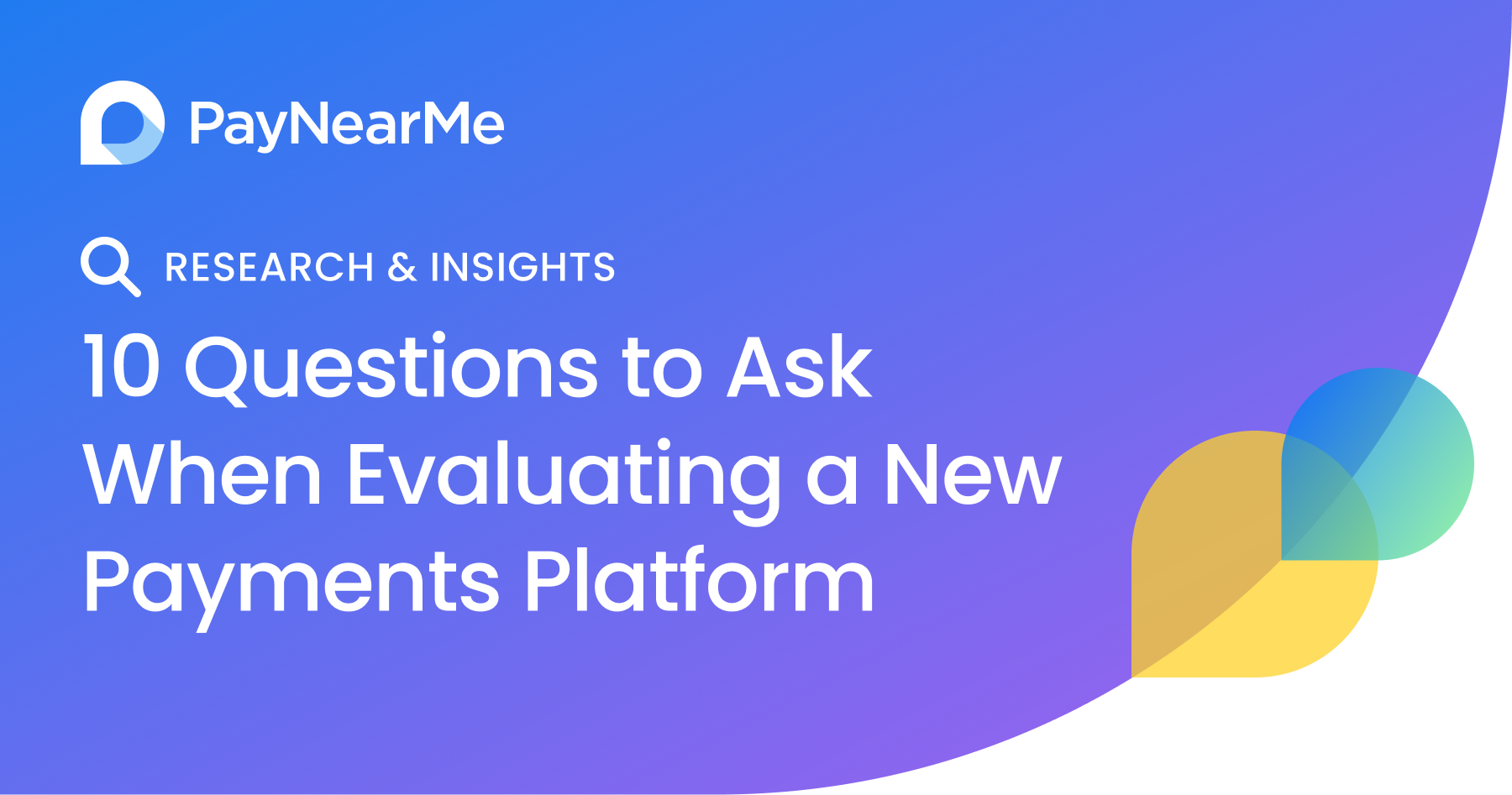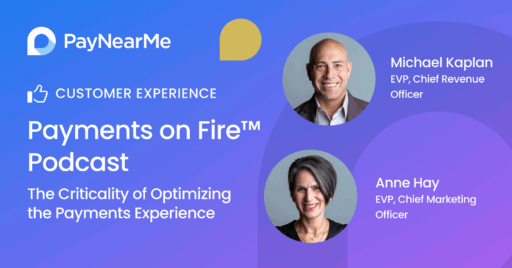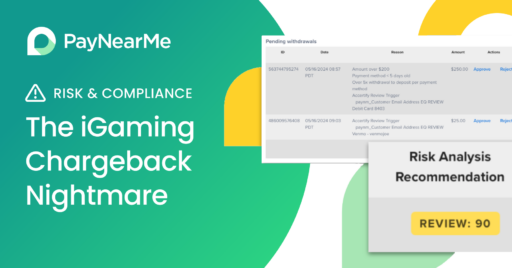10 Questions to Ask When Evaluating a New Payments Platform

Choosing a new bill payment platform is a major strategic decision. It requires building alignment across numerous stakeholders to support competing priorities and your overall vision for company growth. To avoid getting lost in the weeds of every feature, it’s helpful to focus on core factors that may influence how you assess and choose a new provider.
For instance, you’ll want to consider critical areas like payment options, customer experience and back-office management, as well as technical aspects like configurability, integrations, security and support.
In PayNearMe’s Buyer’s Guide for Choosing the Right Payment Provider, we dive deep into 10 key topics for evaluating a platform, each with a series of questions to help guide your RFP and purchase process.
As a launch point, here we’ll introduce the 10 evaluation factors and related questions to consider to help make the decision process easier.
1. What payment options and channels are available?
Considering how customers will pay you is an obvious place to start. Bill pay that supports only ACH and cards is outdated. Today’s consumers want the flexibility to pay how, when and where they choose. That includes diverse channels, from self-service web and mobile, to phone IVR and agent-supported, to paying cash in person.
Deep dive question to ask: Does the platform have native integrations with passthrough and stored value mobile wallets?
Increasingly, consumers want to pay with digital wallets such as PayPal, Venmo, Apple Pay, Google Pay and Cash App Pay. In fact, PayNearMe’s 2024 consumer research found that nearly 60% of people would be very likely or likely to pay their loans via mobile wallet, a substantial jump from 37% in our 2021 survey.
Another factor that underscores how digital wallet adoption is influencing bill pay is that many people (including one-third of unbanked consumers) store cash balances for future use. Among low-income individuals, 47% agreed that being able to pay loans with a stored wallet balance is very important to making it easier to pay.
Patching third-party payment providers onto legacy systems can be costly and complex. And not all payment platforms are built to seamlessly integrate with the latest payment rails. Choose a provider that enables a wide range of payment methods to increase your ability to collect more on-time payments, lower your cost of acceptance and drive down exceptions.
2. How is money movement managed?
Understanding how the payment provider manages the flow of funds in and out of the platform can influence your decision process. For instance, consider how quickly they can settle funds back to you, how well they can handle high transaction volumes as you scale up and how they enable disbursements such as customer refunds.
Deep dive question to ask: What payment methods can you use for disbursements?
Many billers still disburse funds using paper checks, which adds time and cost for preparation and mailing. Checks also introduce more risk of theft, and leave customers waiting. In the aforementioned survey, 67% of surveyed consumers said they wanted to receive funds from their lender via electronic bank transfer. Disbursing via digital channels enables you to move money faster, more cost-efficiently, and more securely, while meeting your customers’ preferences. For example, issuing refunds via ACH, to a debit card or mobile wallet such as Venmo and PayPal can make it easier to meet customer needs quickly, while safeguarding your business.
3. What is the customer payment experience like?
Industry leaders like Amazon, Apple and Uber have excelled at making payments nearly invisible. That’s the new frictionless standard that consumers want everywhere—and that’s what your business needs in a bill pay platform.
The easier it is to pay a bill, the more likely customers may pay on time. And that means ease and self-service convenience across multiple channels, with options personalized to customer preferences.
Deep dive question to ask: Does the platform offer 1-click, personalized payment links?
A modern payments platform should enable personalized links in payment reminders sent via text message or email. Nearly half (47%) of all consumers we surveyed agree that receiving a digital reminder would make it easier to pay on time. With a personalized link, they can jump directly into their payment flow and pay in a few taps, with no login required.
That kind of frictionless self-service payment experience is crucial to reducing your overall cost of acceptance and minimizing manual intervention.
4. How does the platform streamline our back-office?
Simplifying the payment experience for customers is key, but equally important is streamlining operations on the back-end. Look for a platform that offers a robust set of tools that improve efficiency, automate repetitive tasks and give you more control over the payments process.
Deep dive question to ask: How does the platform simplify reconciliation and reporting?
Reducing the burden on reporting can be a big win, especially if your team currently has to reconcile multiple payment files from different partners. Consider a platform that aggregates and clearly organizes transaction data in a single file. And look for opportunities to unlock value from your payments data. Having strong reporting capabilities and export options can equip you to capture insights to help improve personalization, collections, targeted marketing and other strategic business decisions.
5. How does the platform provide stability and reliability?
Every minute your payments provider is down can result in a significant loss for your business. Choosing a fintech partner with zero-downtime capabilities can help reduce risk and provide peace of mind.
Deep dive question to ask: Do product releases require intervention from my IT or development team to complete?
To help avoid the high cost and risk of unplanned downtime, you’ll want a system that’s built with a ‘Plan B’ that can kick in immediately to ensure uninterrupted service for payment acceptance. Ask about ‘redundant card processing’ and whether the platform can manage across multiple payment processors to reduce potential downtime.
6. What systems of record does the platform integrate with?
Being able to send and receive payments data across other systems is vitally important to reduce manual data entry and related errors and costs.
Deep dive question to ask: Do you have a library of APIs and proper documentation to use them?
For starters, you’ll want a payments partner that can send daily data files to your various systems. Beyond that, look for two-way integrations that can push and pull data in real-time, create real-time automations and rules and display real-time balance information to customers.
To future-proof your system, consider a provider that has well-documented APIs to access new capabilities and connect to other systems that need payments data such as third-party platforms for customer email and texting.
7. How configurable is the platform?
The words ‘customize’ and ‘configure’ are often used interchangeably, but in software there’s a distinct difference. Customizing often involves a heavy lift for added development and testing, which gets expensive. Enhanced configurability, however, enables billers to quickly and cost-efficiently gain the capabilities they need, without all the hassles.
Deep dive question to ask: Can you configure the platform to look and sound like my existing systems?
On a basic level, look for a platform that allows you to configure the interface to match your brand and any industry-specific needs. With enhanced controls, you should also be able to create business rules, control risk and fraud thresholds, and more.
8. What kind of support can we expect?
Support is one of the areas where ‘the rubber meets the road’ in a fintech partnership. Evaluate the levels of guidance and technical support you can count on end-to-end, from onboarding and configuration, to solving critical issues and navigating payment industry changes.
Deep dive question to ask: Do you offer dedicated 1:1 account support throughout the life of the agreement?
Investing in a partner with a strong commitment to relationship support can enable you to continue extracting value long after the purchase. Look beyond smooth onboarding, quick response times and reliable updates. You’ll also benefit from a provider that offers ongoing training opportunities and best practices, as well as robust documentation for self-service support.
9. How does the platform reduce our compliance risk?
While you will likely dive deeper with additional reviews for information security and compliance considerations, there are some basics you can assess up front. For example, ensure you have a fintech partner that adheres to PCI-DSS, NACHA and other industry compliance standards. Beyond that, you’ll want to explore other ways to mitigate risk.
Deep dive question to ask: What tools or features does the platform have to minimize exceptions?
Choose a payments platform that helps reduce your risk and compliance scope, such as tools to minimize and efficiently manage chargebacks, returns and other exceptions. Also look for the ability to create automated rules that help prevent fraud and increase adoption of self-service and autopay.
10. What is the pricing structure?
When looking at cost, it’s important to go beyond the advertised per-transaction rate and focus on the different ways the platform can lower your total cost of payment acceptance.
Deep dive question to ask: What kind of ROI can you expect from switching to this platform?
Many billers think only in terms of transaction costs, but there are many hidden costs that can erode profits. Dealing with exceptions, delinquencies and the fallout from a rigid or subpar user experience can all drive up costs. The right modern payments platform can provide multiple ways to lower the cost of acceptance, from automated workflows to lowering call center costs by making self-service payments easier and more intuitive for customers.
Take the next step for your RFP
When it comes to choosing the right payments provider for your business, we know every company is unique and has their own considerations. As a follow-up to this overview, you can explore more questions to guide your evaluation in our sample RFP questionnaire.
For a deeper dive, take advantage of our Buyer’s Guide for choosing a payment provider.



